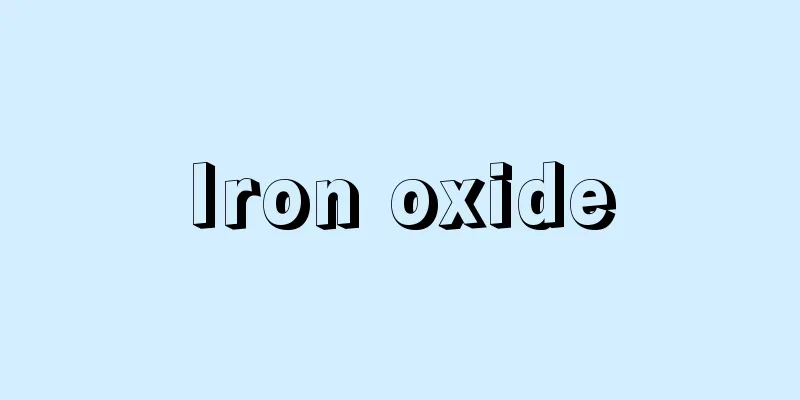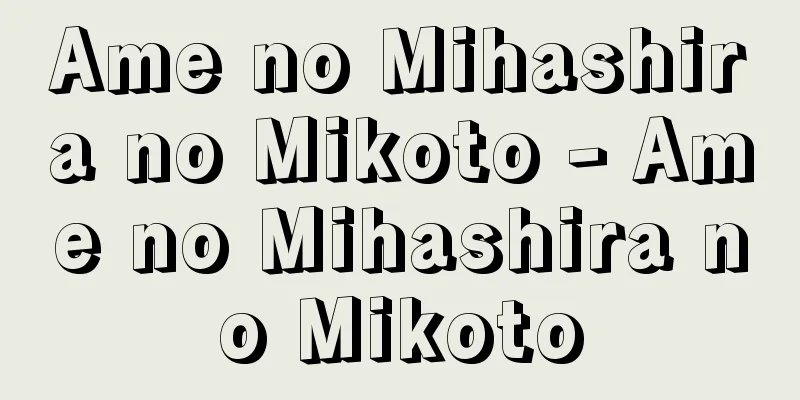Iron oxide

|
A compound of iron and oxygen. Three types are known, but none of them strictly follow the law of definite proportions. In other words, their compositions are ideally FeO, Fe 2 O 3 and Fe 3 O 4 , but in reality they are not simply integer ratios, and there is a certain range depending on the conditions of existence and the manufacturing method. (1) Iron(II) oxide (ferrous oxide) When iron is heated to above 575°C under low oxygen partial pressure and then rapidly cooled, it is obtained as black crystals. At atmospheric pressure, the limit of the composition is Fe0.95O . When metallic iron is added to this and kept at 770°C under 50 kilobars of pressure, the stoichiometric composition is obtained for the first time. Both are black crystals with a sodium chloride structure. Below 198K, they undergo a low symmetry transformation and exhibit antiferromagnetism. They can also be obtained by pyrolyzing iron(II) oxalate, FeC2O4 , in the absence of air, but this produces a black pyrophoric powder whose reactivity decreases when treated at high temperatures. It is reduced by hydrogen to produce iron. This reaction is used as one of the methods for producing pure iron. (2) Iron(III) oxide (ferric oxide) When reddish-brown hydrated iron oxide (α (alpha)-iron(III) hydroxide) produced by hydrolysis of iron(III) salts is heated at 200°C, it is obtained as a reddish-brown powder. Industrially, it is produced by thermally decomposing iron sulfate produced from waste liquid in the steel and plating industries. The substance obtained in this way is called α-iron oxide, and occurs naturally as hematite. It is a paramagnetic substance that belongs to the trigonal crystal system and has an α-alumina type structure. Its color can range from dark red to bright red depending on the manufacturing method. It has the property of absorbing moisture from moist air and dissolves gradually in acid. It is commonly called red iron oxide and is used as a red pigment and glass abrasive. Iron(III) oxide can be produced by carefully heating triiron tetroxide (iron(III) oxide, iron(II)) or by heating pyrite (γ-iron(III) hydroxide), which is another type of iron oxide called gamma-iron oxide. It belongs to the cubic crystal system and has a spinel structure. It is ferromagnetic. It is an unstable modification and does not occur in nature. When heated above about 400 °C in air, it changes to the α-type, but in a vacuum it forms triiron tetroxide at 250 °C. (3) Ferrous(III) Iron(II) Oxide (Ferrous and Ferric Oxides) Although triiron tetroxide is also a correct name, it is sometimes mistakenly called triiron tetroxide. It exists naturally as magnetite, and is an important ore of iron along with hematite. Pure iron can be obtained by reducing iron(III) oxide with hydrogen containing water vapor. It can also be obtained by heating iron in air, oxygen, or water vapor, but in this case the oxide remains on the surface only. It is a black, ferromagnetic substance that is considered to be a mixed oxide of iron(III) and iron(II) and has an inverse spinel structure. It is the most stable of all iron oxides. In powder form it dissolves in acid, but once melted and solidified it becomes strongly passive, and is not only insoluble in acid but also resistant to strong oxidizing agents. It is used in electrodes, black pigments, printing inks, etc. [Torii Yasuo] [References] | | | [Additional information] | | |Source: Shogakukan Encyclopedia Nipponica About Encyclopedia Nipponica Information | Legend |
|
鉄と酸素の化合物。3種類が知られているが、いずれも厳密には定比例の法則には従わない。すなわち、それぞれの組成は、理想的にはFeO、Fe2O3、Fe3O4であるが、実際には簡単な整数比ではなく、しかも、存在条件や製法によって、ある程度の幅をもっている。 (1)酸化鉄(Ⅱ)(酸化第一鉄) 鉄を酸素分圧を低くして575℃以上に加熱したのち急冷すると黒色の結晶として得られる。大気圧の下ではFe0.95Oが組成の限界である。これに金属鉄を加え、50キロ気圧の下で770℃に保つと、初めて化学量論的組成のものが得られる。いずれも黒色の結晶で、塩化ナトリウム型構造をとる。198K以下で低対称性の変態となり、反強磁性を示す。シュウ酸鉄(Ⅱ)FeC2O4を空気を断って熱分解しても得られるが、これは黒色発火性の粉末で、高温で処理すると反応性は低下する。水素によって還元され鉄を生ずる。この反応は純鉄の製法の一つとして用いられる。 (2)酸化鉄(Ⅲ)(酸化第二鉄) 鉄(Ⅲ)塩の加水分解より生ずる赤褐色の水和酸化鉄(α(アルファ)-水酸化鉄(Ⅲ))を200℃で熱すると赤褐色粉末として得られる。工業的には鉄鋼工業やめっき工業の廃液から生成する硫酸鉄を熱分解して製造する。このようにして得られたものはα-酸化鉄とよばれ、天然には赤鉄鉱として産出する。常磁性の物質で、三方晶系に属し、α-アルミナ型構造をとる。製法によって暗赤色から鮮赤色まで色調が変わる。湿った空気から水分を吸収する性質があり、酸に徐々に溶ける。俗にべんがらとよばれ、赤色顔料やガラス研摩材に使われる。 酸化鉄(Ⅲ)の製造にあたって、四酸化三鉄(酸化二鉄(Ⅲ)鉄(Ⅱ))を原料としてこれを注意深く熱するか、あるいはリン鉄鉱(γ(ガンマ)-水酸化鉄(Ⅲ))を加熱すると、γ-酸化鉄とよばれる別の型の酸化鉄が得られる。等軸晶系に属し、スピネル型構造をとる。強磁性を示す。不安定な変態で天然には存在しない。空気中で約400℃以上に熱するとα-型に変わるが、真空中では250℃で四酸化三鉄を生ずる。 (3)酸化二鉄(Ⅲ)鉄(Ⅱ)(酸化第一鉄第二鉄) 四酸化三鉄も正しい名称であるが、誤って四三酸化鉄とよばれることもある。天然には磁鉄鉱として存在し、赤鉄鉱とともに鉄の重要な鉱石である。純粋なものは、酸化鉄(Ⅲ)を、水蒸気を含んだ水素で還元することによって得られる。鉄を空気、酸素または水蒸気中で加熱しても得られるが、この場合は表面だけにとどまる。黒色、強磁性の物質で、鉄(Ⅲ)と鉄(Ⅱ)の混合酸化物と考えられ、逆スピネル構造をとる。鉄の酸化物中もっとも安定である。粉末状のものは酸に溶けるが、いったん融解して固めたものは強固な不動態となり、酸に溶けないだけでなく、強力な酸化剤にも侵されない。電極、黒色顔料、印刷インキなどに用いられる。 [鳥居泰男] [参照項目] | | | [補完資料] | | |出典 小学館 日本大百科全書(ニッポニカ)日本大百科全書(ニッポニカ)について 情報 | 凡例 |
>>: Oxidative phosphorylation (oxidative phosphorylation)
Recommend
The Times Literary Supplement
A British literary weekly magazine, commonly known...
Primrose - Primrose
...A greenhouse species. (6) Primula auricula L. ...
Zhang Hua
A Chinese writer and politician from the Western ...
"Flower tradition book since Kao" - Kao Irai no Kadensho
...The Tanigawa school is mentioned in the "...
Pharyngeal sac
…In vertebrates, the anterior part of the digesti...
Christian Art - Christ Today Art
It refers to all art related to Christianity. It ...
Copernicia alba (English spelling) Coperniciaalba
…[Sumihiko Hatsushima]. … *Some of the terminolog...
Gurdon, Sir John Bertrand
Born October 2, 1933. Dippenhall, British developm...
Saisho-e
A seven-day ceremony held from March 7th to 13th ...
Club - Club
The most primitive weapons and hunting tools used...
Prenatal Pediatrics - Prenatal Pediatrics
A branch of pediatrics that deals with childhood d...
Hand towel (tenugui) - Tenugui
A long, narrow cloth used to wipe hands and sweat,...
Dry Climate
A climate where trees do not grow due to dryness....
Basiliscus plumifrons (English spelling)
…Iguana [Takahiro Matsui]. . . *Some of the termi...
Actio (English spelling)
In Roman law, it meant a ceremonial and legal act,...









